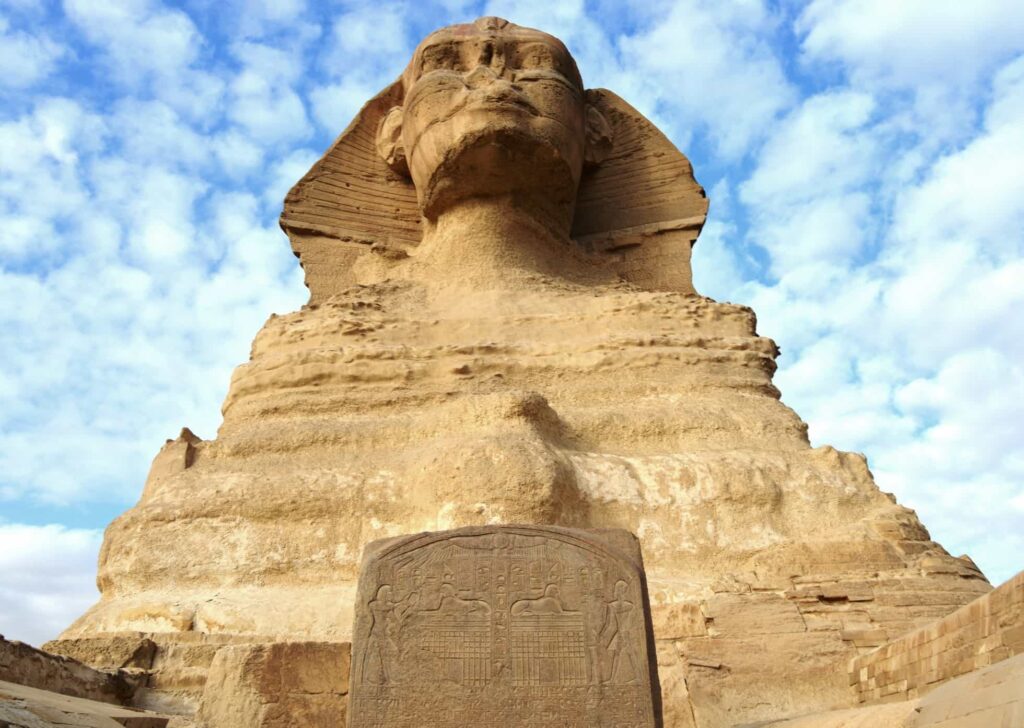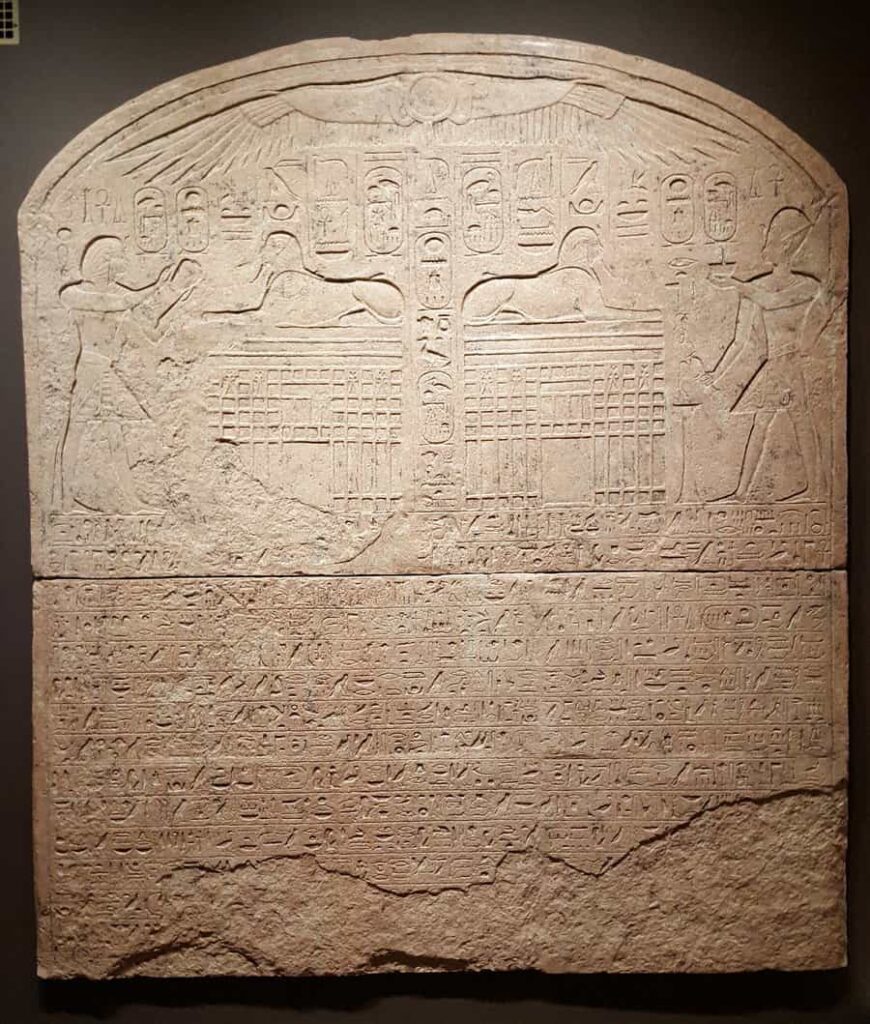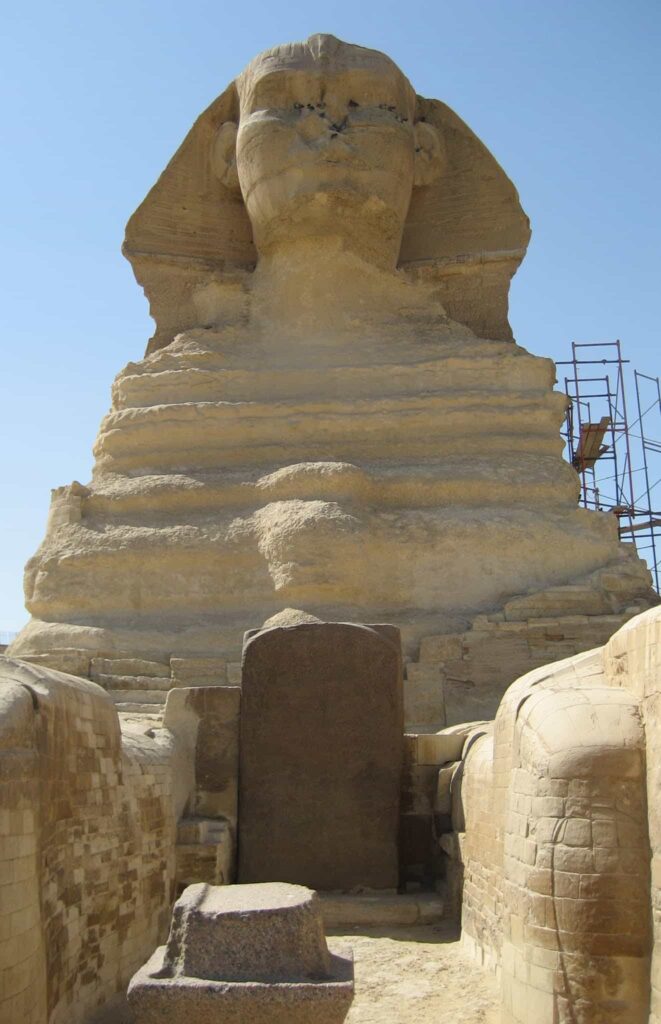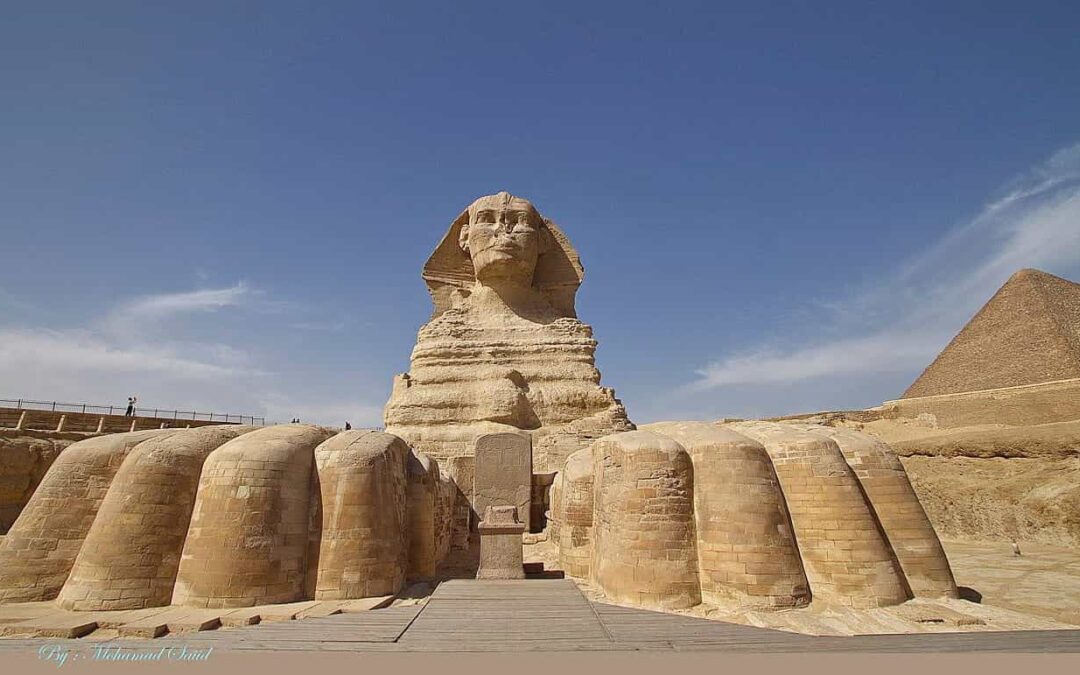“The Dream Stele,” also known as the “Sphinx Stele,” is a stele that dates back to approximately 1401 BC, belonging to ancient Egyptian art.
It was created during the first year of the reign of the eighth pharaoh of the 18th dynasty of Egypt, Thutmose IV.
The Dream Stele was erected between the front legs of the monument known as the Great Sphinx of Giza, which is located in the city of Giza on the west bank of the Nile River in Egypt.
Researchers believe that the stele may have originally been the back wall of a small open-air chapel built between the Sphinx’s legs.
It is worth noting that in 1818, the Dream Stele was rediscovered during the cleaning and restoration of the Sphinx of Giza, which was carried out by the Italian explorer, navigator, and Egyptologist Giovanni Battista Caviglia.
Description:
The stela measures 360 cm in height, 218 cm in width, and 70 cm in thickness, with a weight of 15 tons. It is made of pink granite stone and features carved scenes and hieroglyphic text created using incision and carving techniques.
This epigraphic stela depicts how, when Pharaoh Thutmose IV was young, he fell asleep next to the Sphinx. In a dream, the Sphinx appeared and offered him the throne of ancient Egypt if he would only free it from the sand that had covered its body.
The upper part of the stela is divided into two sections, with representations of Pharaoh Thutmose IV on both sides (left and right). On one side, he is depicted standing while making an offering of incense, and on the other side, he is also standing while making a libation (pouring a liquid, probably wine or water).
In both cases, Pharaoh Thutmose IV is shown making offerings to the Sphinx, which is represented twice on a high pedestal with a door at the base.
It is worth noting that during the New Kingdom of ancient Egypt, the Sphinx of Giza symbolized Harakhty “Harmakhis” (the god of dawn and dusk, as well as the personification of the royal office of divine origin).
The middle and lower parts of the stela are composed of a hieroglyphic inscription, although the text is currently fragmented due to a large, asymmetric crack that begins in the twelfth line. In the following two lines, there is only partial preservation. Moreover, due to the stela’s restoration and size, researchers believe that approximately half of the inscription may be missing.
“The preserved text is approximately translated as follows:
On the nineteenth day of the third month of the first season, in the first year under the protection of Horus, favorite of the two goddesses, enduring like the creator god Atum, the Golden Horus, powerful sword that repels the nine bows.
Men-kheperu-Ra, the son of Ra, the pharaoh of Upper and Lower Egypt.
Thutmose IV, beloved of Amun, who gives everlasting life, stability, and dominion as Ra.
Long live the God, son of Atum, protector of Hor-akhty, living image of the all-lord-sovereign, begotten of Ra. Excellent heir of Kheperi, fair-faced like his father.
A pharaoh who finds favor with the Ennead of the nine gods that make up the cosmogony of Heliopolis. He beautifies Memphis, presents the truth to Atum, and stands in the way of Ptah.
He builds monuments to the gods of the South and North, builds their limestone houses, and offers offerings. Atum’s son, Thutmose IV, shines as Ra, Horus’ heir on his throne, giving life to Men-Kheperu-Ra.
“When Pharaoh was young, like Horus, the youth of Khemmis, his beauty was like that of his father’s protector, like God himself. The Host rejoiced in their love for him, as well as his power as the son of Nut, all the princes and all the great ones…”
“Together with two of his followers, he went hunting in the highlands north of Memphis, hunting lions and small game from the desert, in his chariot with his horses swifter than the wind.”
“When his hour of rest came, he went to the sanctuary of Hor-em-akhet, next to Seker in Rostaw, next to the necropolis. Seker presides over the mountain, the splendid place of the beginning of time, before the lords of Kher-ahah, the sacred path of the gods to the necropolis of Heliopolis.”
“The Great Statue of Kheperi rests in that place, the one of great power, splendid in strength, over which stands the shadow of Ra. The quarters of Memphis and all the cities that stand beside him come to him, raising their hands in praise of his face, bringing offerings for his Ka.”
“While Thutmose IV rested in the shadow of this Great God, sleep overtook him at the hour when the sun was at its zenith.
The Revered God was found speaking with his own mouth, as a father speaks to his son, saying:
‘Behold my son, Thutmose IV.
I am your father, Hor-em-akhet-kheperi-Ra-Atum.
I will give you my kingdom on earth, at the head of the living.
You will wear the White Crown and the Red Crown
on the Throne of Geb, the hereditary Prince.
The earth will be yours, in its extension and in its breath,
that on which the eye of the Lord Almighty shines.
The food of the two lands will be yours,
the great tribute of all countries,
lasting for a long period of years.
My face is turned to you, my heart is turned to you.
You will be for me the protector of my affairs, because I am sick in all my members.
The sands of the Sanctuary on which I stand have reached me.
Turn to me to do what I want.
I know you are my son, my protector.
Look, I am with you; I am your leader.'”
When he finished this speech, Pharaoh’s son woke up,
It is worth noting that the rest of the text is lost, but researchers believe that it could contain Pharaoh Thutmose IV’s response to the God and an affirmation of the work carried out around the Sphinx of Giza.
Furthermore, some researchers speculate that the Sphinx’s promise to make Thutmose IV the pharaoh of ancient Egypt if he cleaned the sand suggests that he was not the crown prince. If he were, he would have ascended the throne upon his father’s death (Amenhotep II).
Moreover, other researchers believe that Thutmose IV might have seized the throne from his older brothers, and the stele served only to legitimize his rule. This interpretation is based on the discovery of three finely carved but currently lost steles, which depicted other sons of Amenhotep II making offerings to the Sphinx. The names of these princes were carefully erased on the steles.
The stele is currently in its original position, between the front legs of the Great Sphinx of Giza. However, various reproductions can be seen in different museums worldwide, such as the replica displayed at the Harvard Museum in the United States of America.











